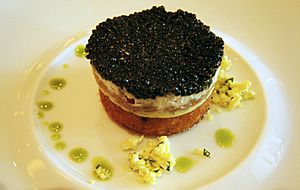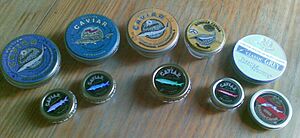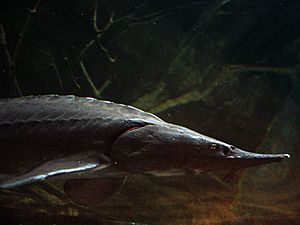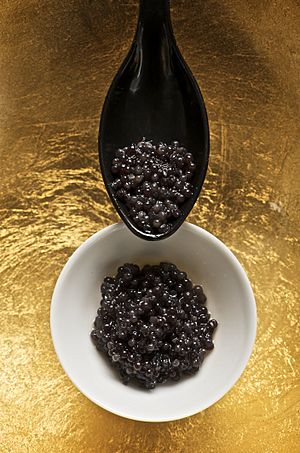Caviar facts for kids

Caviar is a fancy and expensive food. It is made from the processed, salted, and unfertilized eggs (called roe) of sturgeon fish. These eggs can be "fresh" (not cooked) or pasteurized (partially cooked). The fresh kind is usually more valuable and tastes better.
Traditionally, the name caviar was only used for sturgeon roe from wild sturgeon living in the Caspian Sea and Black Sea. These include famous types like Beluga, Ossetra, and Sevruga. These high-quality caviars can be very expensive, costing thousands of dollars per kilogram. They are often served in fancy restaurants.
Sometimes, the word caviar is also used for the roe of other fish, such as salmon, trout, or whitefish. People also use the term for dishes that look like caviar, even if they don't contain fish eggs, like "eggplant caviar." However, organizations like the United Nations' Food and Agriculture Organization say that only roe from sturgeon and paddlefish should be called caviar. Roe from other fish are considered "caviar substitutes."
Caviar is sold all over the world as a special treat. People eat it as a topping or spread, often with small appetizers called hors d'œuvres.
Types of Caviar
Caviar is simply sturgeon roe that has been sieved and lightly salted. The four main types of sturgeon caviar are Beluga, Sterlet, Ossetra, and Sevruga.
The rarest and most expensive type comes from the beluga sturgeon. These fish swim in the Caspian Sea, which is surrounded by countries like Iran, Kazakhstan, Russia, and Azerbaijan. Beluga caviar is known for its soft, very large eggs, which are about the size of a pea. Their color can range from light silver-gray to black.
Next in quality is the small, golden sterlet caviar. This type is very rare and was once only for kings and emperors. After that comes the medium-sized, gray to brownish Ossetra caviar. The last in this quality group is the smaller, gray Sevruga caviar.
When a caviar label says malossol, it means "little salt" in Russian. This shows that the roe was preserved with only a small amount of salt. Fresh caviar spoils quickly and must be kept cold. Pasteurized caviar has been partly cooked, which changes its texture a bit. It lasts longer and might not need to be refrigerated until you open it. Pressed caviar is made from eggs that were damaged or fragile. These eggs are specially treated, salted, and pressed together.
While a spoonful of caviar gives you all the vitamin B-12 you need for a day, it is also high in cholesterol and salt.
Sturgeon caviar is the most expensive kind. Due to too much fishing and pollution, the number of wild sturgeon has dropped. This has led to other, less costly types of roe becoming popular. These include roe from whitefish and North Atlantic salmon. In Russia, catching black caviar was banned for a few years but then allowed again in small amounts.
Other popular and much cheaper types of roe, sometimes called caviar, include:
- Lumpfish caviar: These are tiny, hard eggs, often colored black or red.
- Whitefish caviar: Also called American Golden, these are small, yellow-gold eggs.
- Salmon or red caviar: These are medium-sized eggs, from pale orange to deep red.
- Carp caviar: This is becoming more popular in the United States because carp lay millions of eggs, making it easy to find and cheap.
Sturgeon and Their Environment
In the early 1900s, Canada and the United States were big suppliers of caviar to Europe. They caught sturgeon in the North American midwest and along the Eastern coast. Today, some sturgeon species, like the Shortnose sturgeon, are considered Vulnerable or Endangered because their numbers have dropped a lot.
To help protect wild sturgeon, some fish farms have started raising them. For example, a farm in Spain called Caviar de Riofrio produces organic caviar. This way of farming sturgeon helps make caviar without harming wild populations.
Raising sturgeon in farms, known as aquaculture, is a good way to produce caviar sustainably. This is happening in places like Italy, Spain, France, Uruguay, the Middle East, and California. Hackleback caviar is a popular and affordable product from these farms. Paddlefish, which are related to sturgeon, are also being farmed more often.
The Caspian Sea used to produce 90 percent of the world's caviar. However, too much fishing, illegal trade, and pollution from sewage have greatly reduced the number of sturgeon in the sea.
Caviar in Culture
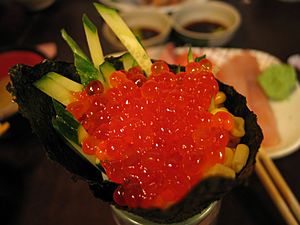
Because it is so expensive in Western countries, caviar is often seen as a symbol of luxury and wealth. In Russia and other Eastern European countries, even though it's still costly, caviar is often served at special events like holiday feasts and weddings. In Russia, the term "caviar" usually includes both sturgeon roe (black caviar) and salmon roe (red caviar), and one is not necessarily considered better than the other.
Images for kids
-
The rarest and most expensive form of caviar comes from the critically endangered beluga sturgeon that swims in the Caspian Sea
-
Caviar substitutes
See also
 In Spanish: Caviar para niños
In Spanish: Caviar para niños


